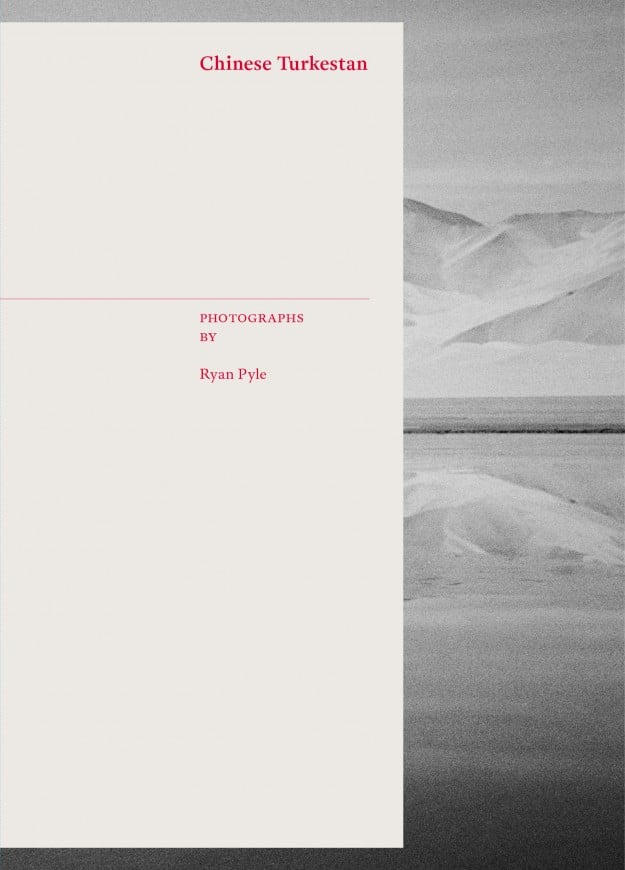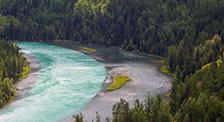“Timeless” Xinjiang | Interview with Ryan Pyle
I had the opportunity this last month to chat with Ryan Pyle, a Shanghai-based photographer and producer best known here in China for his 20,000 km motorcycle journey across the whole country.
He’s been described as an “anthropologist with a camera” and I think you’ll see by the photos below exactly why that is.
I’ve always known he had a strong connection with Xinjiang and it was finally confirmed earlier this year when I learned he was publishing Chinese Turkestan, a beautiful photographic documentary of this region and its people.
The book is available on Amazon, but before you check it out you should read the interview below. He shared with me what first drew him to Xinjiang, how he was able to capture its timeless elements on film, and which places here he would consider his favorite.

Josh: Could you share with us what first brought you to China and, more specifically, to Xinjiang?
Ryan: I made an initial trip to China in 2001 just backpacking around on my own and that is when I fell in love not only with China but also the region of Xinjiang. It was because of that initial trip that made me want to move to China and to spend so much time photographing the region of Xinjiang.
Josh: Considering that China has 34 provincial-level administrative units, what was it about Xinjiang that prompted you to publish Chinese Turkestan instead of another province?
Ryan: Well, I had a really nice time there! I’m a lover of travel writing. I’m a lover of romantic travel writing. I love the romanticism of the Silk Road and had read a lot of books about the Silk Road.
To be out there in Kashgar in the market, and this was back in 2001 when the livestock market was actually right in the city center, not in the suburbs like it is now – it’s just a magical feeling. You felt like you were being transported back in time. There was almost nothing modern about the town. There were very few high-rises back then and I really liked it.
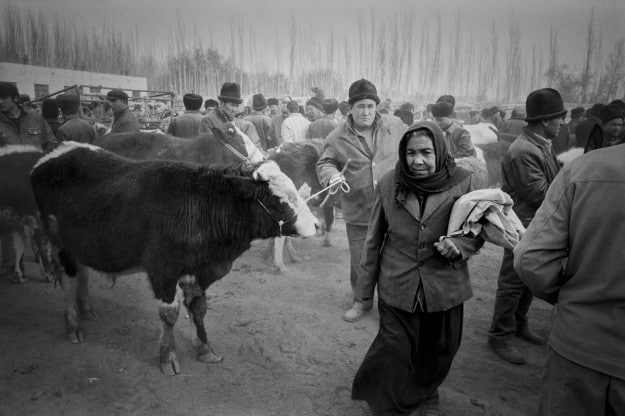
And of course the people are brilliant. Anybody who’s traveled to Xinjiang will tell you about hospitality and great people and of course great Xinjiang food. Such proud culture and such proud history. All of those things really romanticized the idea of that part of China for me and very much made me want to go back and focus on the culture and people.
Josh: One of my favorite photos from the book takes place in front of the Id Kah Mosque in Kashgar. Was that your most memorable experience or is there something else you would consider.
It’s one of the most beautiful places I think I’ve ever been.”
Ryan: Oh, there are so many. Just to be totally clear, the book is about the whole region, so throughout the book you’ll see images of the Mongolian minority people in Biyanbulak. You’ll see Tajiks, you’ll see Kirgiz, you’ll see Uzbek. You’ll see Kazakh minority peoples from all over. Some of the most memorable moments were actually far away from the city on the border with Kirghizstan and Xinjiang, China. It’s one of the most beautiful places I think I’ve ever been.
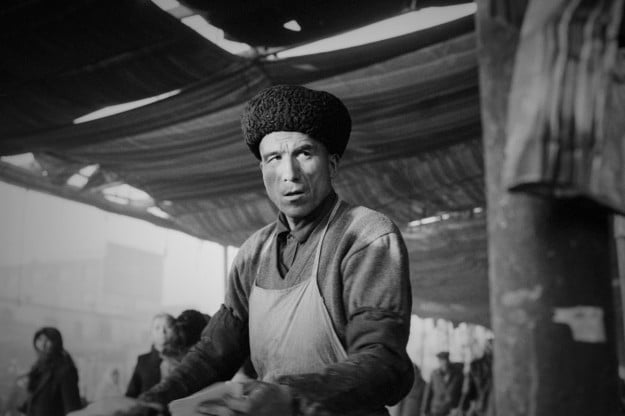
We were out there for days and one day we were just sitting down having lunch and this guy just came by with 10 camels. He was walking between villages and these villages were 4-days walk apart!
He had this camel caravan and I thought “This could be 1820…no one would know the difference!” Those kinds of moments really capture the idea of what that region still is. The fun thing is that imagery in the book takes place from 2004 to 2012, so you see some changes in cities like Kashgar and Khotan throughout this whole photography book.
Josh: I’ve read that Chinese Turkistan was shot entirely on your Leica M6 using black and white Kodak TriX 400. I’m almost certain that you own other great travel cameras and I’ve seen pictures you’ve taken of Xinjiang that are color, so what were you hoping to accomplish by using these specific tools?
You must be the grandson of the photographer” she said, “because these must have been taken in the 1920’s right?”
Ryan: I think I was searching for the romanticism of the age. I’ll tell you a funny story: I was in Brighton in the UK and I was giving a gallery exhibition of my work from Xinjiang and a lady came up to me and she said “Oh, you must be the grandson of the photographer, because these must have been taken in the 1920’s, right?”
“No, ma’am, these are my images; these were all taken after 2004.”
She said “You can’t be serious! They look like they are from a bygone era.”
And I think that subconsciously—actually consciously—I was looking for that. I definitely wanted to make a book about the people and the place and I wanted it to have a timeless element.
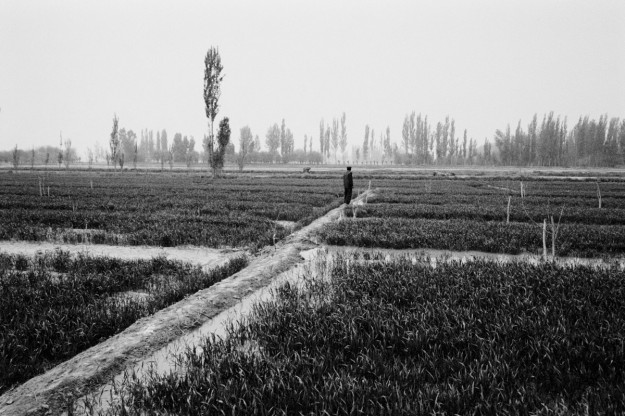
You know, there are a few frames in there that do show a bit of a change, and I feel like that was important to show—like there are high-rise buildings an then there’s the reconstruction of the old City in Kashgar and how they are building up, but for the most part, if you look at the imagery of the book, you couldn’t tell when that image was photographed between today and a hundred years ago.
That was definitely part of the goal—is to document these people’s lives, looking at it in a timeless element.
Josh: Did you experience any unique challenges in Xinjiang?
Ryan: No, I really didn’t have any problems. I visited Xinjiang four or five times a year, each time for about one to two weeks. Sometimes I’d stay two to three weeks if I was lucky, and I just had the most amazing time.
That was definitely part of the goal…looking at [Xinjiang] in a timeless element.”
I never had any problems with police. I never photographed any police, I never photographed any military people. There’s not one image of any of that kind of stuff in the book and I did that on purpose. I wanted it to be purely about the place and purely about the people. I didn’t want to make a political statement.
If you do want to visit and have that kind of experience, just focusing solely on the people, you really don’t get yourself into any trouble. It was really nice. The most difficult thing I did was get that shot that you mentioned earlier of the Id Kah Mosque at the end of Ramadan when everyone is praying in the square at dusk at first light. That was a hard shot because I had to go on a building rooftop, and when I went on the rooftop there were some police there watching the festivities as well, watching the crowd. They asked me what I was doing.
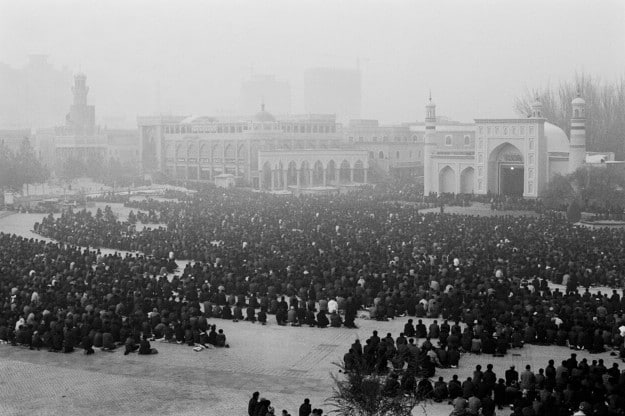
That was the only time I ran into any authoritative government intervention in my work. Otherwise, it was a very peaceful and enjoyable and therapeutic kind of photography project.
Josh: If you were to have the opportunity to vacation out here with your family, which part of Xinjiang would you choose?
Ryan: If I could come back, I’m a bit of an outdoorsman and I really enjoy being out in the middle of nature, and if I could pick one place, I’d probably want to pitch a tent right next to Karakul Lake, sit back and cook dinner on a little fire looking out over Muztagata. I think that’s one of my favorite places.
A close runner-up might be Baiyanbulik in the center of the TianShan Range, and it’s a beautiful, high-altitude grassland, very similar to Tibet, and there’s a lot of Mongolian herders out there—just park a tent out there and enjoy the stars at night—the sky is just lit up—a pretty, pretty spot. Those would be the two places I would enjoy the most.
Josh: You hold a Guinness world record, you’ve traveled around the world, you’ve been honored as one of the emerging photographers in 2009. Of all these accomplishments, what sits on your mantle at home as the one you’re most proud of?
Ryan: I think it is this book I just published about Xinjiang.
You should know that the book was self-published by my own team because there were no publishers that were interested in it. I tried for many years to get the work published in major magazines and to bring on various publishers both in Europe and North America and they all rejected the topic and rejected the medium I was working in which was black and white. They said this really wasn’t for us, and that was really discouraging. But I just wanted to continue on.
I was sitting in a hostel in Beijing and people were saying ‘Don’t go to Xinjiang’…”
To finally publish the book and have it out have it available that you could see it learn from it is really a great feeling of accomplishment because not only do you have to battle the elements and distance and the time you spend in Xinjiang which is always difficult—you have to battle a publishing industry that suppresses some stories. Spending eight years on something and not being able to share it would have been the worst fate possible!
I love anthropology, I love looking at how people live, I love understanding about where people live and why they’re living the way they live—and all the work I do have some element of that in it. All I want to do is travel and explore and then tell people about this and share it with as many people as possible.
I feel that in in many ways the world just doesn’t know enough about others parts and other places. The news is so segregated and so focused on conflict areas that places like Xinjiang get left off the map. When the spotlight does turn there, it’s all about the violence that is happening there. It’s had its problems, sure, but there is so much more of a story to tell.
Before I first went to Xinjiang in 2001, I was sitting in a hostel in Beijing and people were saying “Don’t go to Xinjiang” and the Chinese and other foreigners were saying “Don’t go to Xinjiang.” But I went out there, and I had the most amazing time. It was such and eye-opening experience.
If you are going out there with an open heart and an open mind you’re bound to be fulfilled by what you find. I definitely was.
If you [go to Xinjiang] with an open heart and an open mind you’re bound to be fulfilled by what you find.

Thanks to Ryan for his time and permission to publish these photos, all of which are his. At this point there are two things you can do if you appreciate the years of work this book represents:
- Buy a copy of Chinese Turkestan on Amazon to have for yourself and enjoy the countless other beautiful timeless photos of Xinjiang.
- Will you be traveling to Xinjiang? Check out the FarWestChina Xinjiang Travel Guide, the most comprehensive book about travel around the region.
- Even if you’re not inclined to buy the book, you can still help promote his work simply by tweeting about it or sharing it on Facebook.

